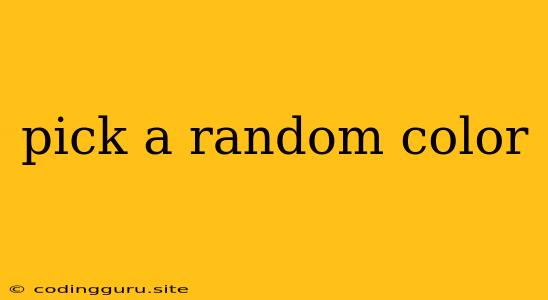Picking a Random Color: A Beginner's Guide to Adding a Touch of Randomness to Your Projects
Adding a touch of randomness can make your projects more dynamic and engaging. One common way to achieve this is by picking a random color. Whether you're designing a website, creating a visual art piece, or simply adding some flair to your code, picking a random color can inject a dose of unpredictable excitement.
Why Choose a Random Color?
But why pick a random color in the first place? Here are a few compelling reasons:
- Variety and Visual Interest: Random colors help break monotony and create visually stimulating designs.
- Dynamic User Experiences: Websites and applications can feel more interactive and engaging when colors change unexpectedly.
- Unique Aesthetics: Each time you run your code, you'll get a fresh, new color, leading to a unique visual experience.
- Creative Inspiration: Random color generation can spark creative ideas and lead to unexpected color combinations you might not have considered otherwise.
How to Pick a Random Color: A Step-by-Step Guide
There are several approaches to picking a random color. Here's a breakdown of popular methods:
1. Using a Random Number Generator
This method involves generating random numbers to represent red, green, and blue (RGB) values. Here's a basic example using JavaScript:
function getRandomColor() {
const r = Math.floor(Math.random() * 256); // Generate random red value
const g = Math.floor(Math.random() * 256); // Generate random green value
const b = Math.floor(Math.random() * 256); // Generate random blue value
return `rgb(${r}, ${g}, ${b})`; // Combine values into a valid RGB string
}
console.log(getRandomColor()); // Outputs a random color in RGB format
This code snippet defines a function called getRandomColor(). Within the function, we use Math.random() to generate three random numbers between 0 and 255, representing the red, green, and blue components of the color. Finally, we combine these components into an RGB string using template literals and return the color.
2. Utilizing Pre-Defined Color Libraries
Many libraries provide a wide selection of pre-defined color palettes, allowing you to pick a random color from a curated set. Examples include:
- Material Design Color Palette: offers a diverse collection of colors categorized by theme and purpose.
- ColorBrewer: provides color palettes designed for data visualization and cartography.
- Coolors.co: offers a user-friendly interface for exploring and generating color palettes.
3. Exploring Online Color Generators
Numerous online tools offer quick and easy ways to pick a random color. Some popular options include:
- RandomColor.com: allows you to customize color ranges and generate random colors based on your preferences.
- CSS Color Generator: provides a visual interface for picking random colors and converting them to various color formats.
Tips for Choosing Random Colors Effectively
- Consider the Context: Think about the purpose of the color and the overall theme of your project.
- Experiment with Ranges: Limit the range of random colors to create a cohesive visual style.
- Utilize Color Theory: Apply basic color theory principles (e.g., complementary colors, analogous colors) to ensure harmonious color combinations.
Examples of Random Color Usage
- Interactive Backgrounds: Websites can have backgrounds that change color randomly with each page load or on user interaction.
- Dynamic Art Pieces: Generate random colors to create abstract art or interactive animations.
- Data Visualization: Use random colors to distinguish different data points or categories in a chart or graph.
Conclusion
Picking a random color is a simple yet powerful technique to add a touch of randomness to your projects. By understanding the different methods and applying some basic design principles, you can create unique, visually stimulating, and dynamic experiences. Whether you're a beginner or an experienced developer, exploring the world of random colors can open up a realm of creative possibilities.
